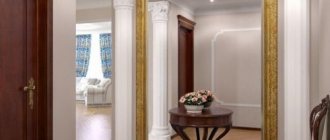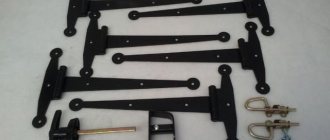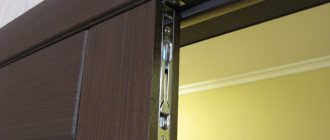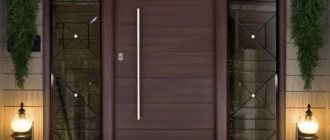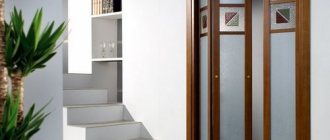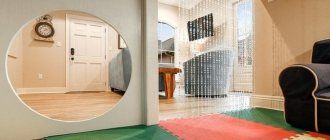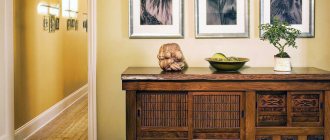Even if the door structure was installed efficiently and reliably, from time to time you will need to carry out preventive work to adjust the awnings. We will tell you how often such activities need to be carried out, what steps are involved in debugging door hinges, and how various types of awnings are adjusted.
Adjusting door hinges
Why are door hinges needed?
In order for interior or entrance structures to work reliably, they must have high quality not only the canvas and frame, but also other elements. These door canopies are needed for smooth, easy opening and closing. They ensure reliable fixation of the canvas in the box. There are high demands on the strength of door hinges. If you hang flimsy elements on a massive structure, the canvas will soon sag. Doors are visible, so they must fit into the interior of the room, and this applies to every detail.
How to determine the need for adjustment work
Loop adjustment must be carried out under the following conditions:
- The door began to close (open) only when a certain force was applied;
- The canvas no longer adheres tightly to the box. The joint density must be assessed along the entire perimeter of the structure;
- The stable position of the structure has been disrupted;
- Friction appeared when closing the structure between the canvas and the box;
- There are malfunctions in the clamping mechanism.
If you notice at least one such malfunction, then it’s time to start adjusting the awnings. And the sooner you perform preventative maintenance, the longer the product will serve you. If you do not debug the operation of the canopies, during further operation the structure may sag, the canvas or frame itself may shift, and such breakdowns are more difficult to eliminate and the cost of repairs can be quite high.
Types of door hinges
Construction stores offer a large selection of entrance and interior structures. Plastic and metal sheets with boxes come complete with all the necessary elements. Door hinges for interior doors made of wood or MDF must be purchased separately. In order not to make a mistake when choosing them, it is important to take into account their main classification characteristics:
- installation location;
- fastening methods;
- types of structures;
- manufacturing material.
Overhead door hinges
This type of canopy is the most popular because it does not require special installation skills. Such door hinges without mortise are installed without the use of a chisel or router. For fabric weighing up to 20 kg, two similar elements are enough. However, butterfly door hinges are not suitable for heavier structures. Advantages of overlay elements:
- quick installation;
- low cost;
- universal use.
Flaws:
- small load;
- non-removable element;
- low quality;
- short service life.
Mortise door hinges
This model is similar in appearance to the overhead structure. In addition, mortise door hinges are arranged according to the card principle. They are installed at the end of the canvas, which does not spoil the appearance of the structure and ensures smooth operation. Mortise door hinges for heavy doors are used to preserve the design of the entrance or interior structure without changing. Advantages of the models:
- universal use;
- simple installation;
- long service life;
- low cost.
Flaws:
- high risk of distortion;
- small load;
- mandatory unscrewing during dismantling.
Corner door hinges
Such elements differ in their appearance, but not in functionality. Instead of straight plates, they have corners that are attached to the axial rod. Such corner card canopies are a type of straight structures. They are fastened in the same way as mortise hinges. Advantages of corner models:
- possible installation on canvases with a rebate;
- low cost;
- increased strength;
- long service life.
Flaws:
- difficulty during installation;
- impossibility of hiding in the canvas.
Screw-in door hinges
This type of canopy is produced mainly in European factories. Screw-in or pin door hinges are used primarily on rebated structures. In appearance, these are two cylinders that are screwed into the frame and sash. Hidden door hinges are equipped with threaded pins and decorative caps. A plastic bushing with a hardened ball is responsible for noiselessness and smooth operation. The advantages of these models are:
- neat appearance;
- low cost;
- versatile adjustment.
Flaws:
- low load;
- complex installation;
- non-removable model.
Hidden door hinges
Such canopies are included with modern European models. Hidden hinges for doors are successfully combined with designs in high-tech or modern style. They are often embedded into the canvas already at the factory, but they can also be purchased at hardware stores. Hidden door hinges have a number of advantages:
- invisible on the structure;
- adjustment horizontally, vertically and clamping.
Flaws:
- complex installation;
- small angle for plowing;
- non-removable option;
- high price
Double-sided door hinges
These types of canopies are suitable for different types of canvases. Adjustable double-sided door hinges can be selected regardless of which way the structure opens. This is a very convenient option for interior options. Advantages of double-sided door hinges:
- suitable for left and right structures;
- can withstand heavy weight of the canvas;
- serve for a long time.
Flaws:
- poor compatibility with modern, high-tech and other modern styles;
- inconvenient design for installation and dismantling.
Adjusting window hinges
To adjust the hinges of plastic windows you will need:
- hex key No. 4, made in the shape of the letter L;
- various screwdrivers;
- pliers.
To adjust, you need to pay attention to the following elements:
- bottom loop, which is rotary. By adjusting this hinge, you can align the window sash vertically and the lower part of the sash horizontally;
- a hinge located at the top, which is tilt-and-turn. Adjusting this element of the fittings allows you to achieve the correct position of the window in the right-left direction;
- locking pins. The fittings are located around the perimeter of the window. By adjusting the trunnions, the clamping force is equalized, that is, the location is closer or further away.
Horizontal adjustment
To adjust the window horizontally, you need to:
- open the sash;
- remove the decorative trims covering the hinges;
- insert the hex key into the special hole located in the side of the hinge;
- if you rotate the key in a clockwise direction, the window sash will move closer to the hinge located in the upper part, and, accordingly, vice versa.
The optimal position of the window can only be achieved by simultaneously adjusting the upper and lower hinges.
Vertical adjustment
The position of the window in the vertical direction can be adjusted exclusively using the lower hinge. To perform the procedure you must:
- install the key in the hole that is located at the top of the hinge at the end;
- the window sash will rise if the key is turned clockwise and lower in the opposite direction.
Adjusting the pressure
The force of pressing the window against the frame is produced by adjusting the hinges and pins.
To increase attraction in the area of window hinges, you must:
- remove decorative trims from the outer part of the hinges;
- Using a hex wrench, rotate the bolt located on the outside of the hinge.
The locking pins are adjusted according to the diagram shown in the figure.
Adjusting door and window hinges allows you to achieve the optimal location of the door leaf or window sash relative to the frame or frame. Correct adjustment helps to increase the service life of fittings and doors (windows).
It is difficult to imagine any home, no matter how many rooms it has, without interior doors. First of all, this enclosing structure is necessary for bathrooms and toilet rooms. Therefore, it is important that interior doors work properly for a long time. For this purpose, at the final stage of door installation, it is adjusted.
In addition, it is often necessary to adjust old doors. It is this process that we will try to understand in our article. But let's start with a general description of the structural elements of an interior door.
Often homeowners, who are not naturally deprived of the ability to do manual labor, decide to independently install and adjust the doors of rooms in their home. In principle, such work can be done with your own hands. But first, it is important for beginners to know what an interior door is made of.
The main structural element of any door is the door leaf; it is what people first pay attention to when purchasing a door. Another name for the canvas is sash.
Installation of the door and its operation is impossible without the frame, which is installed in the doorway, and the leaf itself is attached to it. The frame is an original structural element of each specific door, matching it in color. This means that installing a new sash in an old frame is not possible. Often the box comes complete with the finished canvas. It consists of three or four elements. If the door is planned without a threshold, then the frame is U-shaped, it includes 2 long vertical beams (hinged and rebated) and one short horizontal one (lintel). If necessary, the box design includes a threshold, in which case it will look like a closed loop.
The decorative function is performed by the platband. It is this that closes the seam where the door frame is installed in the wall opening.
If the thickness of the wall is greater than the thickness of the door frame, then an additional strip is needed. It is also a decorative element, the color of which matches the canvas.
An important part of the doors is the fittings, which include two hinges on which the door leaf is attached to the frame, a latch and a set of handles. For doors installed, for example, in a bathroom or toilet, a locking device is also provided that allows you to close the door from the inside.
These are the main structural elements of interior doors.
Method of fastening door hinges
Installation of fasteners depends on their type and fabric material. The easiest way to install a universal door hinge, but mortise structures and corner models require certain dexterity and skills. Fastening is conveniently done using an electric milling cutter. It completely replaces a chisel and is needed to correct the corners of the blade. To perform fastening, you need a set of tools and accessories:
- hammer and chisel;
- screwdriver;
- self-tapping screws;
- wooden wedges;
- construction level.
How to choose door hinges?
When purchasing canvas awnings, it is necessary to take into account not only the material of the entrance or interior structure. You need to know that door hinges are divided into three types:
- Steel
, which are considered the most reliable and durable. However, they are not aesthetically attractive. - Brass
, which become a decoration for the door structure. Their service life is greatly limited by the softness of the metal. - Brass plated
, which are imitation of brass analogues. They are made from alloys that give them a distinctive appearance. Rubbing parts wear out quickly.
Other factors to consider when choosing door hinges include:
- Web weight
. For example, reinforced door hinges are required for heavy doors. In addition, the increased size of the structure requires the installation of an additional loop. - Availability of bearings
. They help doors open and close smoothly, without squeaking. - Direction of movement
. This determines which loop you need to choose: left, right or universal.
How to install door hinges?
Any type of canopy is installed after careful measurements and markings. The following algorithm will tell you how to properly install door hinges:
- From the top to the bottom edge, retreat 20-25 cm and make a mark with a carpenter's pencil. It is important that there are no knots or damage to the wood where the hinges are installed. Their presence will cause difficulties when screwing the screws.
- The edges of the door hinges are applied to the marks on the canvas. Then their outline is precisely outlined.
- Using a chisel, cut down according to the marks made. It is important that the beveled part of the tool is directed towards the loop. The size of the recess should not exceed the thickness of the metal.
- Using a chisel and hammer, a sample of wood is made.
- The hinges for the doors are secured using self-tapping screws of the required sizes.
Similar actions are carried out during installation of the vertical part on the door frame. Contour outlines are cut out, hanging the canvas on wooden wedges. In this case, you need to leave a gap of 2-3 mm at the bottom, top and along the side edges of the canvas. Temporary fixation is achieved using wooden wedges. Moreover, the canvas should not be allowed to deviate horizontally or vertically. In the future, this may cause distortion of the entrance or interior model.
Adjusting a hinge with a support ball or with bearings
This type of hinge is adjusted using a screw located at the top. When tightening the screw, its lower part will rest against the ball (or pin of the hinge) and lift the door leaf. This must be done as the metal wears away. Having completely unscrewed the screw, you can lubricate the hinge mechanism through the hole, after which the screw is returned to its place. This way you can correctly install the door leaf and reduce the load on the hinges and closure devices. This procedure must be carried out periodically, since as a result the adjustment of the loops is disrupted.
Adjusting the hinges is the last stage of installing fittings on doors and windows. With the help of adjustment, you can achieve smooth opening of the door (window), fix it in a certain position, and also eliminate gaps or excessive contact between the door leaf (window sash) and the door frame (window frame). How to adjust hinges on windows and doors of various types (including furniture ones, read on.
How to adjust door hinges?
After installation of the structure, final adjustments must be made. All door hinges, mortise or overhead, require adjustment. During installation, defects may have occurred that need to be corrected. If you skip this step, unpleasant consequences will soon appear in the form of creaking, deformation or distortion of the door structure. Interior or entrance door partitions made of wood or metal are subject to deformation due to the large mass of the canvas. The procedure for adjusting door hinges is as follows:
- Pinpoint exactly where friction and squeaks occur. To do this, you need to listen to the door during use. You can simply inspect the surface of the structure to identify abrasions.
- Use a hex key to loosen one of the hinges. Sometimes the two middle ones are unscrewed at once. This depends on the number of hinges installed on the entrance or interior door.
- Gradually move on to loosening the second loop. It should be located close to the point of friction or squeaking.
- Carefully remove the door leaf from the frame. Then press it, paying attention to its position. It should be parallel to the box and placed perpendicular to the floor.
- Tighten the adjusting nuts on the outer loop. Then shake the canvas with light movements so that all the hinges for the door are installed in their places.
- Finally tighten all fasteners and check the accuracy of the settings.
Frequency of adjustment and preventive work
It is important to understand that the more often a door structure is used, the more often preventive measures need to be taken. For example, adjustment of hinges on entrance doors should be carried out more often than on interior structures.
Also, metal structures need to be carried out as frequently as possible, because such products are heavy. Due to heavy load, the fastener parts weaken and may even break or cause the metal sheet to sag significantly. Timely adjustment of the hinges on a metal door can save you from such undesirable consequences.
Adjusting door hinges
The frequency of preventive measures may also depend on the design of the canopies themselves. First, you will need to establish exactly what type of fastener is installed on the door mechanism, and only then begin repair or maintenance work.
Door fasteners can be hinged, mortise, hidden, bar, screw-in type. On lightweight products, overhead elements are usually installed; for heavy types, mortise parts are used. Entrance doors made of metal are equipped with fasteners with a support bearing, or hinges with a ball made of brass or carbon steel.
How to lubricate door hinges to prevent squeaks?
Improper fastening of awnings during installation can lead to a whole range of structural problems. One of the troubles that may arise may be an annoying squeak when opening or closing the door. This is due to the hinges and facing rubbing against each other. After final adjustment, door hinges without mortise or concealed models require special lubrication. This procedure must be carried out periodically. Experts recommend how to lubricate door hinges:
- any machine oil;
- universal lubricant;
- special oil for sewing machines;
- technical grease;
- vegetable oil;
- pencil lead;
- melted wax or paraffin.
Adjusting a metal entrance door
- creak;
- draft - blowing from under the canvas (cracks around the perimeter or from above/bottom);
- closes with difficulty.
The solution to all these problems is called “adjusting the front door,” but this includes very different measures - from banal lubrication and replacement of the seal, to actual adjustments and mechanical influences.
Sometimes, to fix a problem, you need to go through all the methods, and sometimes the problem that has arisen can only be eliminated radically - by replacement. Most often, this situation occurs with cheap Chinese products. Adjusting Chinese-made entrance doors is almost impossible. Of course, you can try to do something with your own hands: companies and craftsmen do not undertake them.
Eliminating the squeak
Doors can creak for two reasons: the hinge grease is clogged or the door leaf touches the frame. Although both are called “creaking”, the nature of the sound is different. It’s easier to deal with clogged loops, so they usually start with this procedure.
Hinge lubrication
First, remove the old grease, at the same time removing any dirt stuck to it. The procedure is standard: wipe with a soft cloth wherever marks are visible. If this procedure has not been done for several years, and the hinges are of a standard classic type, and even detachable, the fabric can be removed. It is better to clean it when removed.
If the hinges are rusty and cannot be removed even though they should, do not try to knock them off with a hammer or sledgehammer. You'll do more harm than good. It is better to buy a rust remover. It is usually sold in the form of sprays. Apply to the rusted hinge and wait for the prescribed period. Then remove the fabric from the loops and clean it. But this time it is necessary to remove all the rust. To bare metal, then coat with rust converter and only then with lubricant.
After the old lubricant is removed, take “fresh” and apply it to the hinges. If the blade is removed, no problems will arise - lubricate the pin and ring. If there are any other rubbing mechanisms visible on the frame, lubricate them too.
In traditional type hinges, creaking may occur due to the fact that the washer on the rod has worn off. You inspect it after you have removed the door panel. If there are signs of wear, replace them. Install a new carbide washer. You can use an engraver instead. It will also compensate for the load.
If the hinges are permanent, find a liquid lubricant in a can (the most common is WD40) or machine oil, which can be applied using a large syringe. Handle all rubbing parts carefully.
There is another method, but it is destructive. A hole is drilled in the upper part of the loop, which is then filled with lubricant. The trick is to not damage the mechanism inside.
If the hinges are hidden, find all the turning parts and lubricate them. Often these models have holes into which oil is applied.
After applying the lubricant, rock the doors from side to side several times, distributing the lubricant. If this was the reason, the squeak goes away. The final touch is to wipe off excess oil.
How to lubricate front door hinges
You must select a lubricant primarily based on the temperatures at which the loop is operated. If the loops go outside, you need a composition that does not thicken at low temperatures. There's not much choice here:
- Litol. Operates reliably at temperatures from -40°C to +120°C.
- Solid oil. The temperature range is slightly lower, but also sufficient: from -35°C to +65°C.
For entrance doors facing the entrance and operated at above-zero temperatures, several more items can be added to this list:
Eliminating friction on the box
If the creaking remains after processing the hinges, it is most likely caused by friction of the door leaf against the frame. Inspect the door frame for scuffs. If you find any signs of abrasion, look at which loop is closest. It will need to be regulated, if possible.
The difficulty is that there are a lot of types and models of loops and it is impossible to say unambiguously what needs to be done. All that is possible is to list the main points that may exist. Based on them, you may be able to determine how to “treat” your door.
Two types of hinges for an entrance metal door with adjustment
Standard hinges do not provide adjustment options. In this case, adjusting the entrance doors consists of replacing the washer. Select them of greater or lesser thickness, adjusting the position of the door leaf. Some hinges with a ball at the top have an adjustment screw. By unscrewing it, we lift the doors a little, and by twisting it, we lower them. You can try to correct the situation with its help.
If standard hinges on a steel door are welded, we can assume that the possibilities have been exhausted. If they are mounted on screws, loosen the fastening screws and move the sash in the desired direction as far as possible. Then the screws are tightened. Check to see if the problem has gone away. If not, try with another loop. Sometimes it is necessary to loosen all the loops and tug the canvas in this position. In general, decide where to press and where to press.
There are hinge models in which the adjustment holes are hidden under a protective cap. But you can’t just remove it: it is secured with a bolt that can be unscrewed from inside the room. An example of adjusting such a loop is in the video.
If the hinges on the front door are screwed on, you can use them to eliminate friction between the door leaf and the frame. First, loosen the screws near the area where the wear occurs. Try to move the door leaf a little. To begin with, you can knock with your palm or fist, moving it in the desired direction. Try opening/closing a couple of times. Did it help? Screw the clamping screws back. And try to open/close again.
If it doesn’t help, you can use some kind of leverage, hit it with a rubber mallet or hammer through the board. But don't overdo it. You need to handle Chinese products especially carefully: they are very flimsy.
If these manipulations also do not yield anything, you will have to loosen the screws on all the hinges and try to move the canvas over the entire area. Take the edge of the canvas with your hands and shake it. In this case, the loops should fall into place. You try to open and close. If there is no squeak, tighten the bolts. That's all, adjusting the front door hinges can't do more. The next thing you can try is to change the geometry of the door frame. More on this in the next paragraph.
The photo above (right picture) shows an adjustable hinge. By loosening the screws, you can turn the adjusting screw. It doesn’t help - we try to move the canvas as described above.
Eliminating a leaky door (blowing from under the door)
Sometimes there is a noticeable blow from under the front door. If you examine the perimeter, you will most likely find that in some place the fit of the door leaf to the door frame is loose. There may be a decent sized gap. You can check your suspicions with a piece of paper. Open the doors, insert a piece of paper between the door leaf and the jamb and close the doors. If the rebate is normal, the paper either stretches with very great force, or is clamped so tightly that it is impossible to remove it. Just break it up. If the sheet comes out freely, then the fit is insufficient.
The simplest explanation is that the seal has lost its elasticity. If the doors are several years old, this is possible. And the first thing you do is change the seal. Didn't help or only partially solved the problem? Let's move on.
Replacing the seal is the first step if there is leakage from under the front door
If the door leaf is displaced relative to the door in the horizontal plane, we try to eliminate the draft from under the front door by first moving the door leaf. This is described above: loosen the fastening screws on the hinges, then try to move the blade in the desired direction. Check the result - the gap has disappeared - tighten all the screws to their original position.
Sometimes gaps under the front door occur due to the door frame being skewed. This is checked using a level. Most likely, it is skewed in the place where the sheet of paper can be easily removed. The second option, on the contrary, the box was pushed out in the place where the sheet is pressed, due to the fact that the “normal” part cannot be pressed. All this is determined using an eye gauge and a level. Having determined what the problem is, we try to return the geometry to normal. The measures depend on how the box is installed:
For an option to correct the gap in the vestibule, see the video. After installing the front door
It turned out that it was blowing strongly from under it. The owner corrected the distortion with a hammer.
Eliminating door sag (shuffles on the threshold)
If, after several years of operation, the doors begin to open with difficulty and rub against the threshold, most likely the problem is that the ball or bearings have worn out. If there are possible adjustments, you won’t even have to remove them. Simply unscrew one of the bolts and lift it slightly up.
If there is no adjustment, there are several options:
- replacing hinges;
- replacing bearings with new ones;
- installation of washers instead of bearings.
All this is determined based on the situation and the design of the loop.
